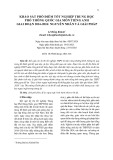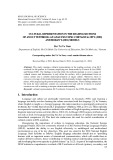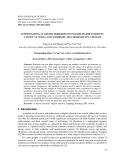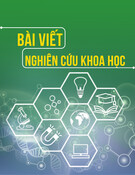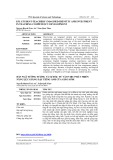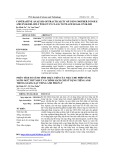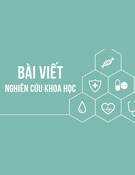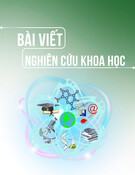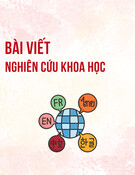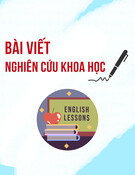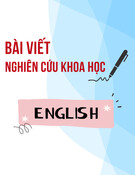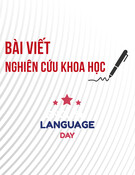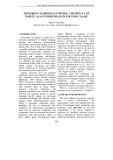
89
HNUE JOURNAL OF SCIENCE
Educational Sciences 2024, Volume 69, Issue 3, pp. 89-98
This paper is available online at https://hnuejs.edu.vn
DOI: 10.18173/2354-1075.2024-0050
AN INVESTIGATION INTO THE EFFECT OF TEXTBOOK ADAPTATION
ON SECONDARY SCHOOL STUDENTS’ LANGUAGE PROFICIENCY
Tran Nguyen Ngan Ha1*, Ta Thanh Tan2 and Nguyen Minh Ngoc1
1Victoria Thang Long Primary and Secondary School, Hanoi city, Vietnam
2Faculty of Philology, Hanoi National University of Education, Hanoi city, Vietnam
Corresponding author Tran Nguyen Ngan Ha, e-mail: trannganha7277@gmail.com.
Received May 14, 2024. Revised June 18, 2024. Accepted July 12, 2024.
Abstract. To investigate the effects of authentic English textbook adaptation in ESL
classrooms, this study analyzes students’ English proficiency levels before and after
experiencing an adapted version of National Geographic’s Reach E (2016). It first presents
the process of adaptation (based on the Pre-While-Post model); then, it compares students’
scores to demonstrate its impact through a series of statistical tests and interviews with the
teacher for more information on students’ in-class behaviors. The results show that students
who studied the adapted version of the textbook performed better than their peers did without
it. Though other uncontrollable factors are considered, the data and the teacher's perspective
suggest that textbook adaptation can bolster students’ language proficiency.
Keywords: textbook adaptation, ESL, English textbook adaptation, Vietnamese English
learner, Reach E.
1. Introduction
With the priority of effective and ethical English education for young learners, the
Vietnamese Ministry of Education and Training issued Circular No. 32/2018/TT-BGDĐT on
December 26th, 2018, promulgating the general education program, including the English
curriculum. While the application of this curriculum can guide students to approach national
standards, the demand for a higher level of competence has prompted a rise in international and
bilingual private schools which adopt United States (US)-based, British, or Australian English
textbooks. This call for immersive English education is common among monolinguals and non-
native-speaking nations wherein foreign language competency is associated with other desirable
qualities that precede academic or professional success. Supriyono et al (2020) study claims that
English immersion programs can yield benefits parallel to language acquisition such as “cultural
awareness” and a “high level of academic achievement”. Irfan (2021) attributes the language to a
crucial role in the country’s political and socio-economical infrastructure, calling for the ESL
curriculum to “develop(s) critical awareness, self-reflection, critical thinking, and learner
strategies” (Irfan, 2021:976). Vietnamese private schools’ momentum toward authentic teaching
material is, similar to the aforementioned nations, supported on the ground that these curricula
would equip its students with a skillset suitable to a globalizing world wherein English is the
powerful lingua franca that bridges its fluent speakers to promising opportunities.

Tran NNH *, Ta TT & Nguyen MN
90
2. Content
2.1. Literature review
While the average English-speaking student uses the language as a tool to access authentic
textbooks’ content, English language acquisition is the main goal for an ESL learner in Vietnam.
This gap in language competency necessitates adaptation of the original materials; however, a
lack of official uniformity can challenge educators. According to Alih (2020), teachers report that
developing high-quality teaching materials requires tremendous effort (Alih et al, 2020). English-
speaking expatriates who teach English in Chinese universities report considerable resistance
from their students who require them to know more about local testing systems, requirements,
and the way they have learned English (Ling Shi, 2009). Thus, the demand for a well-structured
curriculum and an understanding of local English teaching methods in ESL programs calls for
further studies on how authentic textbook adaptation can best suit teachers' and students’ needs.
In Vietnam, the discourse concerning ESL curriculum has touched on various issues such as the
effects of English programs in a private institution (Do-Na, 2017), key challenges that teachers
in the Mekong Delta are facing (Nguyen et al, 2023), the connection between intentions of the
national English curriculum reformation and its implementation as carried out by teachers (Vu,
2020), implications of university students’ oral language production in advanced curriculum
(Pham, 2017), university students’ perception of Language Training Program for language majors
(Le and Tran, 2021), and the relevance of English for Specific Purpose curriculum (Nguyen,
2017). These studies utilized interviews and/or observations to substantiate their claims. To add
to this conversation, this study focuses on analyzing students’ test scores, proposing a statistical
approach to assess the effectiveness of authentic textbook adaptation.
2.2. Research question
This study focuses on how a private school adapted the K6-level National Geographic
textbook - Reach E - to make the content more accessible for its 6th graders. The textbook,
designed for K-6 students, is divided into 8 chapters, each concerning an overarching theme. One
unit contains two parts (which follow the same structure) before concluding with a writing project.
Initially, the institution designed the syllabus to be faithful to the original content. However, while
the textbook is designed to be taught over 160 hours, ESL students aged 11 had trouble
processing the content in that timeframe. Thus, the curriculum development team simplified and
reorganized Reach E’s materials, centering lessons around detailed instructions and practice. This
study is then conducted to investigate the effectiveness of the changes by comparing two groups
of K6 students’ test scores. Between the groups, one studied the original textbook faithfully for
both academic semesters whilst the other studied the first semester as planned by the textbook
and the second as revised by the curriculum development team. By comparing these results, the
current study seeks the answer to the question: Can a process of simplification and reorganization
of authentic English textbooks improve students’ performance in a second-language education
setting?
2.3. Methodology
2.3.1. Theoretical framework
Several studies have revealed the importance of incorporating authentic materials into ESL
education, such as Smith’s (2018) investigation on the use of magazines, news stories, or articles
in teaching vocabulary, or Lee’s (2018) proposal to use short stories, movie clips, and
advertisements to highlight grammatical structures’ form and use. Shavkatovna (2024) claims that
adaptation of authentic materials to meet the needs and proficiency levels of learners is needed.
Since Reach E is a compilation of useful authentic texts accompanied by vocabulary, grammar,

An investigation into the effect of textbook adaptation on secondary school students’ language proficiency
91
and language lessons, the team approached the process of adaptation with a plan to reorganize
and simplify contents without adding supplementary materials. The team decided to rearrange the
lessons to follow the Pre-While-Post (PWP) model closely to ensure accessibility for learners. In
a PWP model, the pre-reading stage prepares students to read the text, the while-reading stage
helps students to understand the text, and the post-reading stage allows students to make
connections between the text and their ideas or experiences (Davies, 2000). Reach E’s original
organization, based on the assumption that its learners are native speakers, intertwined language,
vocabulary, paragraphs, texts, and syntax lessons. Our team has reorganized the textbook in the
following order: vocabulary, syntax, sentences, paragraphs, and texts. Our assumption is as
follows: for ESL students to access the language, they need to approach smaller units (words and
syntax) before tackling more complex units such as sentences and texts. Simplification occurs
when the team removed the book’s “Fluency” section which teaches students intonations since
the school’s ESL curriculum already tackled this area. Concrete examples of these textbook
adaptation processes are provided in the Results section.
2.3.2. Empirical study
To investigate the effectiveness of textbook adaptation, we looked at the test scores of two
groups of students who studied the original (Group 2223) and adapted textbook (Group 2324).
The test scores were recorded in an Excel file before getting imported into R where we calculated
the mean and standard deviation, as well as visualizing the data, and running t-tests. More
information about the two groups of students and their tests are as follows:
● Group 2223: 18 K6 students of the year 2022-2023 who did not experience any
adapted content. This group has taken two tests - the first-semester assessment test, and
the second-semester assessment test.
● Group 2324: 24 K6 students of the year 2023-2024 who underwent the first
semester of the original textbook and the second semester of the adapted textbook. This
group has taken three tests - one assessment test at the beginning of the school year, a
first-semester assessment test, and a second-semester assessment test.
Despite slight changes in content, each test contains (i) 10 multiple-choice vocabulary
questions; (ii)10 multiple-choice grammar questions; (iii) 6 reading comprehension questions: 4
of which are multiple-choice, 2 of which are short answer questions; and (iv) 1 essay question:
250-300 words, with a familiar topic from the textbook. Although the test aims to test two skills
(reading and writing) and students’ knowledge of vocabulary and grammar, the result of each
student will be combined into one grand score totaling 20. Our purpose is to compare the result
of Group 2324’s second semester (the only semester wherein students studied the adapted
textbook) with the rest to find out whether the adaptation yields positive results. The results are
presented in the following section.
2.4. Results
2.4.1. Textbook adaptation
In this subsection, we present the final production of the textbook simplification,
reorganization, and adaptation process, illustrated by concrete examples.
2.4.1.1. Pre-reading
To best suit the students’ level, the team simplified and reorganized the original content.
Table 1 serves to compare the original and revised pre-reading content. To illustrate how the
adapted structure looks compared to its original counterpart, Table 2 presents the content of Part
1, Unit 5 – “Invaders!”, Reach E. The colors of the boxes indicate the equivalence of the content
between the two textbook versions.

Tran NNH *, Ta TT & Nguyen MN
92
Table 1. Pre-reading content
Original
Adapted
Part
Structure
Objectives
Part
Structure
Objectives
1
Unit
Introduction –
Big question
Students familiarize
themselves with the
overarching themes
1
Introduction
&
Vocabulary
Introduction: Students
familiarize themselves
with the overarching
themes
2
Language
Students learn and
apply a spoken
language frame
Science/Social Studies
Vocabulary: Students
learn the science/social
studies vocabulary
Academic vocabulary:
Students learn the
Academic Vocabulary
3
Science/Social
Studies
Vocabulary
Students learn the
science/social studies
vocabulary
2
Word Work |
Grammar
and Spelling
Word Work: Students
learn vocabulary strategies
or concepts
4
Thinking Map
Students learn and
apply a thinking map
model to organize
ideas
Grammar: Students learn
and apply grammar
structures
5
Academic
Vocabulary
Students learn the
Academic
Vocabulary
3
Language &
Thinking
Map
Language: Students learn
and apply spoken language
frames.
Thinking Map: Students
learn and apply a thinking
map model to organize
ideas
6
Strategic
Reading
Students learn a
reading strategy and
apply it to a short text
4
Strategic
Reading
Students learn a reading
strategy and apply it to a
short text
Table 2. Pre-reading content, Part 1, Unit 5- “Invaders!”,
Reach E, the original versus adapted versions
Original
Adapted
Par
t
Structure
Content
Par
t
Structure
Content
1
Unit
Introduction
–Big question
(p. 282-283)
The big question:
“When do
harmless things
become harmful?”
1
Introduction
&
Vocabulary
Big question: “When do
harmless things become
harmful?”
2
Language
(p.284)
Retell a story
Language frames:
Before ______.
During ______.
After ______.
Science vocabulary (p.285):
decompose (v), experiment (n),
humid (adj), mold (n), spore (n)
Academic vocabulary (p.287):
contain (v), control (v),
environment (n), investigate (v),
spread (v)

An investigation into the effect of textbook adaptation on secondary school students’ language proficiency
93
3
Science
Vocabulary
(p.285)
decompose (v),
experiment (n),
humid (adj), mold
(n), spore (n)
2
Word Work
& Grammar
and Spelling
Word Work (p.304):
Antonyms
4
Thinking
Map (p.286)
Event Chains to
show Plot
Grammar and Spelling (p.
313): Adjectives
5
Academic
Vocabulary
(p.287)
contain (v),
control (v),
environment (n),
investigate (v),
spread (v)
3
Language &
Thinking
Map
Language: Retell a story (p.
284)
Language frames:
Before ______.
During ______.
After ______.
Thinking Map (p.286): Event
Chains to show Plot
6
Strategic
Reading
(pp.288-289)
Making
Inferences
Language frames:
I read _____.
I know _____.
And so _____.
4
Strategic
Reading
(pp.288-289)
Making Inferences
Language frames:
I read _____.
I know _____.
And so _____.
As demonstrated by Tables 1 and Table 2, after the stage of Unit Introduction, the original
textbook presents a verbal language frame/thinking map before vocabulary. The adapted structure
begins with both sets of vocabulary to ensure comprehension, introducing students first to the
smallest unit of language available in the textbook. The team decided to group Word Work and
Grammar and Spelling contents (originally in the post-reading section) into one part which
immediately follows vocabulary, seeing as syntax is the next grammatical unit. The team then
presents Language (oral communication using language frames) and Thinking Map (idea
organization using a thinking map) content together. Finally, the team aims to teach students
reading strategies as intended by the original textbook. In this part, students learn a language
frame that they can use to communicate their assessment of a text, as well as a short reading text
(roughly 100-200 words) on which they can apply the strategies. This structure allows the students
to access the content with clear, condensed objectives for each lesson, ordered from smaller
linguistic units (vocabulary, syntax, paragraphs) to larger ones – sample texts and text.
2.4.1.2. While- and Post-reading
Each part of a Reach E Unit contains one main reading text which averages 10-13 pages and
one shorter reading text which averages 7-11 pages. Table 3 shows how the adapted structure
organizes while-reading and post-reading contents in contrast to the original structure.
Table 3. While-Post reading content
Original
Adapted
Part
Structure
Objectives
Part
Structure
Objectives
1
Main
Reading
Text
Students apply vocabulary and
reading strategies to
comprehend the text’s content
1
Main
Reading
Text
Students apply vocabulary
and reading strategies to
comprehend the text’s content
2
Think
and
Respond
Talk about it: Students verbally
answer reading comprehension
questions
2
Think
and
Respond
Talk about it: Students
verbally answer reading
comprehension questions

